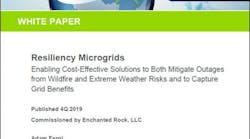Resiliency Microgrids — Enabling Cost-Effective Solutions to Both Mitigate Outages from Wildfire and Extreme Weather Risks
Low cost and modular microgrids can provide long-duration resiliency services to host customer sites while helping integrate variable renewable energy supplies at the grid operations level. The duality such modular microgrids can offer has been clearly demonstrated in the Electricity Reliability Council of Texas (ERCOT) market. Can a similar approach be applied to other markets, such as California?
Deploying smartly resourced microgrids helps address each of these three issues. However, some regulatory constructs stand in the way of releasing the full value of these systems as the world’s electricity markets shift to a greater reliance on distributed energy resources (DER). The issues recommended for reform include resource selection agnosticism, updated rules for integrating resource adequacy (which ties back to transmission-level resource commitments), and a realistic assessment of cleaner alternatives to diesel generators that are still typically the first choice for provision of resilient onsite power.
A key innovation driving reduced costs in the microgrid space is a shift toward modularity and standardization. Customized microgrids meet the precise resiliency, economic, and environmental goals of any customer. However, customization often increases both technology and financing costs. An alternative path to market is to standardize components, thereby simplifying installations and shrinking development timelines and costs.
